Elizabeth Spavento
Corey Arnold is a photographer and commercial fisherman who spends his life traveling both land and sea. Curator, Elizabeth Spavento caught up with him somewhere between Denmark and Seattle, WA to discuss his latest project and muse on the mysterious allure of the ocean.
Elizabeth Spavento: Forgive the pun, but let’s dive right in. Tell me about your experience as a fisherman and how it informed your art making.
Corey Arnold: I grew up in California and went fishing off the coast with my dad. The sea fascinated me; I was drawn to its mystery. You never know what’s gong to come up on your line. Every day is different. There are all these curiosities and creatures that really stoke your interest when you’re a kid, you know? I became a miniature expert on fishing and the science of the ocean. I was my own marine biologist, dissecting sea creatures all the time. Fishing became my identity. I dressed as a big game fisherman for Halloween three or four years in a row, toting around a shark rod and reel around the halls at school.
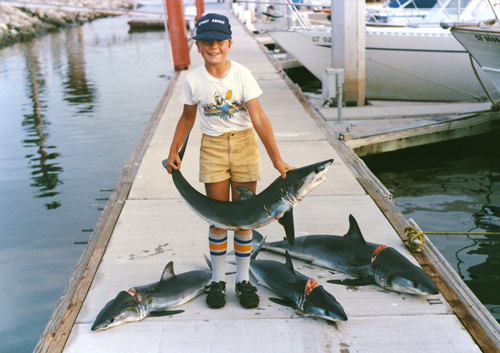
Chris and Corey Arnold, Corey and Mako Sharks, 1986, Archival Pigment Photograph.
So, it was natural for me to continue to explore the sea as an adult. I went to Alaska looking for a fishing job when I was nineteen. I didn’t know much about commercial fishing, but I knew a lot about the ocean to appear like I knew what I was doing. Plus, I could tie knots. Working in Alaska was a big adventure for me, but it was also a way to make money and help pay for school. After I graduated from art school in San Francisco, the dot com boom collapsed and the economy went to shit. It was a very bad time for me to go out on my own as a photographer.
ES: Wait, wait. It’s funny to me that you’re talking about this involved personal history fishing and dressing up like a fisherman until you actually become one and then all of a sudden, you graduated from art school. How does that happen?
CA: Well, my dad was super into fishing and photography, so when I was in elementary and middle school I was going fishing with him on weekends. But as I grew and became a teenager, it felt like a job and it was less about having a good time on the water. I took a lot of time off from fishing at that point. I was more into skateboarding and punk rock and girls and whatever. It was also the same time I started taking photography more seriously—in high school.
But, how did I get into photography? To go all the way back, it was with my dad. He bought me a Pentax K1000 camera when I was ten or eleven years old, so I had this pretty decent 35 mm manual camera when I was just starting to take snaps. Further down the line, I got a lot of encouragement from my high school photography teacher, Scott St. Morris. He took me under his wing, and gave me a lot of positive feedback. I wasn’t super passionate about photography at the time. I just did it and felt encouraged by the people around enough to pursue it. That’s when I decided to go to art school.
By then I needed a summer job to pay for school, so my buddy and I drove to Alaska in 1995. We heard about the chance to make money commercial fishing. The fishing up North was so far beyond my prior experience. Everything I had done in California was child’s play by comparison. It was for fun, it was like a tourist thing, a
lmost.
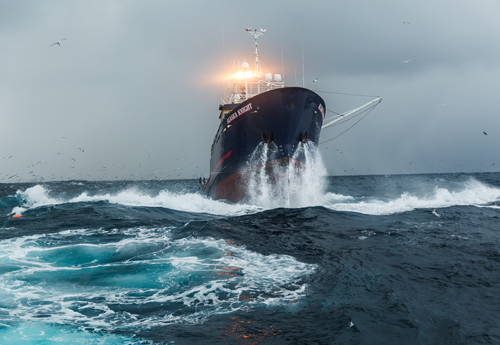
Corey Arnold, Alaska Knight, 2014, Archival Pigment Photograph
Going to Alaska, everything is bigger, and there are massive amounts of fish, horrible weather and grizzly people. I wanted to fit into that scene. Even though I had a really good work ethic, which gets you a lot of cred on the ship, I was this skateboarder from southern California and I was super intimidated. I learned that if you’re an extremely hard worker, everyone respects you; it doesn’t matter what you look like. It’s the work that counts. You can be feminine or…
ES: [Laughs] You can be feminine?
CA: What I mean to say is, there are some pretty badass ladies on these ships. [Pauses] You can already tell I’m rambling on forever.
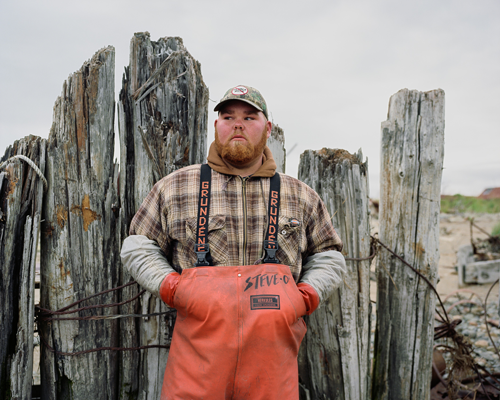
Corey Arnold, Steve-O, 2008, Archival Pigment Photograph
ES: Let’s switch gears. What are you working on right now?
CA: I’ve been working on a project in the Aleutian [Islands in Alaska], but it’s not fully developed. I’m still figuring out where I’m going with it. In previous series I’ve shown work from specific trips—Fish Work, Bering Sea, Europe, Graveyard Point—where I was working as a fisherman and photographing myself in the act. Now I’m more interested in photographing other people and worlds where I’m not fishing. Lately, I’ve been out on a bunch of big factory trawlers cruising in remote areas of the Bering Sea. I’m interested in the contrast between industrial fishing and the natural environment, including life on shore. I went to some of the smaller, remote native villages, like Atka, where the people watch these huge ships pass offshore all the time without ever interacting with them. It’s interesting to see the two perspectives of how the Aleutian Islands are being utilized.
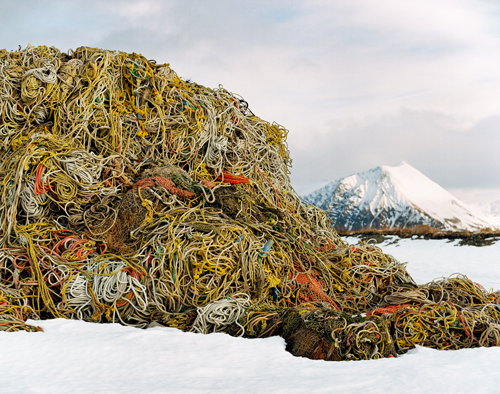
Corey Arnold, Line Mountain, 2008, Archival Pigment Photograph
ES: Do you have a particular side or perspective that you feel more in alignment with?
CA: Well I come from the commercial fishing world, so I’m an outsider in the villages. I could identify with these smaller communities, the underdogs and the people living off the land out there, but my background is in the commercial fishing industry. It’s an exploration. I’m not necessarily trying to make a political statement. I’m not trying to stop fishing in the Bering Sea. I like to let others interpret the work and simply present the information I see.
ES: Is there a reason why you don’t want to make a political statement?
CA: I’ve been a fisherman in Alaska for so long, and I don’t necessarily think that we are raping and pillaging the ocean. We are catching an enormous amount of fish in the Bering Sea, but I think it’s fairly well managed and the abundance is unfathomable. The world needs food—especially wild food, it has a lot of nutrition and is the only way you know it’s not GMO or farmed. Still, you can’t fish for as long as I have and not be hyper conscious of the long-term effects that it has on the environment.
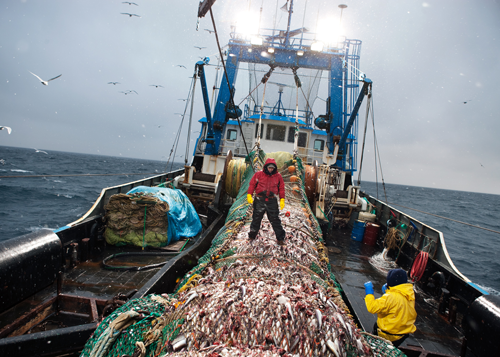
Corey Arnold, Cod End, 2010, Archival Pigment Photograph
ES: You talked about wanting to capture the two perspectives simultaneously and alluded to the fact that this project is still developing. I don’t want to impose a political agenda on the work where there isn’t one, but it seems like the tension between the two perspectives you are trying capture are representative with what I imagine the psyche of the modern fisherman to be. On one hand you’re sustainably harvesting wild food for the masses. On the other hand, you have to acknowledge that the earth and the living things in it deserve respect because they provide finite resources for us to go on living. These are things you can’t take lightly, or at least you have to pay attention to how they are balanced.
CA: Yes, there is a duality. At sea, I see quiet moments of pristine nature with eagles and mountains and the water, and then suddenly a gigantic trawl net comes up with, like, a million pounds of fish in it. You can look at that photo and hear the sounds almost, the grinding and the gears and the industry itself. Or the other moments when the wildlife meets the fishing boats, like when the eagles land on the rigging. I’m always thinking about these birds and the crazy experiences they have. They’ll be chilling on land, sleeping and pecking at their feathers, being eagles in nature, and then they fly off to perch on garbage cans or human refuse and feed off their most recent catch. They’re living this dual life, living among us and in this wild habitat. I’m trying to get to a place in my photography where I can juxtapose man to nature without needing to stop or change it. I’m not saying that anything is good or bad; I’m just relating what happens. This is what is happening.
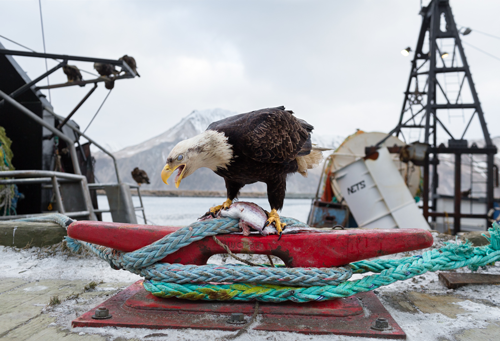
Corey Arnold, Fight or Flight, 2014, Archival Pigment Photograph
ES: If you’re trying to capture something as vast as life itself, then that endeavor implies death, right? Because those things are always in delicate balance. Life emerges from that cycle of death and decay.
CA: Exactly! That’s what I’m trying to capture with what I’ve been documenting recently. Like an eagle chowing on a fish with boats in the background looking super dirty and evil. Or some of the at-sea images where ridiculous quantities of fish are pulled up in massive trawl nets, strewn in the air with shaggy strings and seaweed hanging off of them. When you look at it, you’re like ‘what the hell is that?’ It’s surreal, this industrial equipment that is so foreign to its surroundings and fish death on a massive scale. Everything about everything up there [in Alaska] is unique and otherworldly.
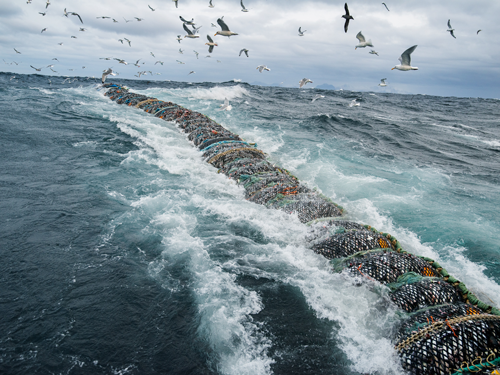
Corey Arnold, Pollock Log, 2015, Archival Pigment Photograph
ES: Right, when I think about you as an artist, I don’t think of you as preparing for a specific exhibition so much as working on a continuum of images in which all these ideas are related. Working like that—without categories—gives you the freedom to observe without an agenda. The work isn’t about two perspectives in tension. It’s a personal survey of the sea.
CA: That’s how I feel about my projects. The images could be mixed and matched in several ways without having to be tied to a specific location or experience. I’ve photographed my life the same way as I am cruising through. You know that photo of the three guys walking on the mud up to the abandoned building? You know that shot that I’m talking about? It sets the tone of this great mystery and this great adventure on land and sea.

Corey Arnold, Nakeen, 2010, Archival Pigment Photograph
ES: Do you have ye olde epic sea story? All fishermen have some wild tale about the one that got away or the one that was so big but never made it on camera. What’s yours?
CA: The most epic thing that ever happened to me was in Graveyard Point, but it’s a long chain of events that involves a massive storm and dramatic rescue—I don’t know how to possibly explain it all. In Graveyard Point we’re living in this abandoned cannery in the middle of Bristol Bay, Alaska. It’s super remote. There’s over one hundred fisherman fishing out of these really small boats. We’re pulling nets loaded with Sockeye salmon by hand during the day. We don’t sleep on the boats, so we’re camping in the abandoned buildings at night. We encounter grizzly bears and crazy amounts of mosquitoes, and everything just looks wildly different than the Alaska most people envision. The water is brown and muddy and the landscape is flat and swampy. So…. [Sighs] Yeah. [Hesitates] I just don’t know if this is the right story to tell. There’s so much to it. What I mean is, it’s super hard to describe what was so harsh about the whole situation.
ES: Is there something that you captured in any of the images from Graveyard Point that would help convey that atmosphere?
CA: When I’m in Graveyard Point, I’m running the boat and stuff so it’s hard to take photos when there’s water and fish slime everywhere. I just don’t think I could even convey the drama of what happened that night. Sorry to tease you.
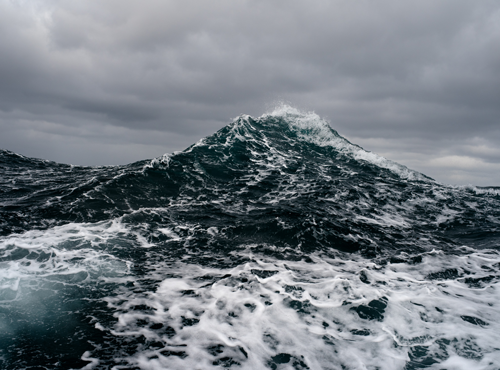
Corey Arnold, Wake and Sea, 2015, Archival Pigment Photograph
Corey Arnold is a photographer and commercial fisherman. Working as a deckhand in Alaska since 1995, he spent seven years aboard the Bering Sea crabbing vessel f/v Rollo. He now captains a wild sockeye salmon fishing operation based out of an abandoned cannery complex called Graveyard Point. His life’s work, Fish-Work is an ongoing photographic series that explores the commercial fishing lifestyle worldwide. His Photographs have been exhibited widely and published in the New Yorker, the Paris Review, Time, The New York Times, Harper’s, and National Geographic among others. He is represented by Charles A. Hartman Fine Art in Portland, Oregon and Richard Heller Gallery in Santa Monica, California.
Elizabeth Spavento is a Portland-based independent curator and writer interested in millennial culture, unstructured time and alternative states of consciousness. She has organized exhibitions in New York, NY and Portland, OR and is recently co-curating ALL RISE, a series of temporary public artworks for a 90,000 sq. ft. empty lot in downtown Seattle, WA. Her newest exhibition exploring race and identity will feature works by new media artist Mario Lemafa and will take place in February 2016 at Interstitial Gallery in Seattle, WA.